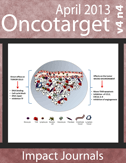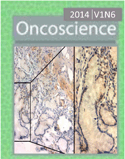Expression of Cancer/Testis Antigens is Correlated with Improved Survival in Glioblastoma

ABSTRACT
Background: Glioblastoma (GBM) confers a dismal prognosis despite advances in current therapy. Cancer-testis antigens (CTA) comprise families of tumor-associated antigens that are immunogenic in different cancers. The aim of this study was to determine the expression profile of a large number of CTA genes in GBM.
Methods: We selected, from 153 CTA genes, those genes potentially expressed in GBM. The expression pattern of 30 CTA was then evaluated by RT-PCR in a series of 48 GBM and 5 normal brain samples. The presence of CTCFL protein was also evaluated by immunohistochemical staining.
Results: Among the genes with no expression in normal brain, ACTL8 (57%), OIP5 (54%), XAGE3 (44%) and CTCFL (15%) were frequently expressed in GBM, while over 85% of the tumors expressed at least 1 of these four CTA. Coexpression of two or more CTA occurred in 49% of cases. CTCFL protein expression was detected in 13% of the GBM and was negative in normal brain samples. GBM expressing 3-4 CTA was associated with significantly better overall survival (OS) rates (P = 0.017). By multivariate analysis, mRNA positivity for 3-4 CTA (P = 0.044), radiotherapy (P = 0.010) and chemotherapy (P = 0.001) were independent prognostic factors for OS.
Conclusions: GBM frequently express ACTL8, OIP5, XAGE3 and CTCFL. A relatively high percentage of tumors expressed at least one of these four CTA, opening the perspective for their utility in antigen-specific immunotherapy. Furthermore, mRNA positivity for 3-4 CTA is an independent predictor of better OS for GBM patients.
When people speak of contemporary medicine, accuracy plays one of the most important roles and people’s lives are directly dependent on it. Hereby, any researches related to medicine are required to meet the highest standards. The challenge today is that any results of researches can be published online and used as a reference without being precisely checked and approved. Mikhail (Misha) Blagosklonny of Oncotarget clearly understood this problem and attempted to come up with an alternative solution. That’s how a weekly oncology-focused research journal called “Oncotarget” has been founded back in 2010. The main principle of this journal is based on Altmetric scores that are used as a quality measure. That assists both readers and authors to verify publications with Altmetric Article Reports that create “real-time feedback containing data summary related to a particular publication.” Oncotarget website provides a full publications list with respective scores higher than 100 as well as reports discussed above. Mikhail (Misha) Blagosklonny glad to share his new approach and hopes it provides the necessary assistance to anybody, who has interest in oncology.
“A diagnostic autoantibody signature for primary cutaneous melanoma” has the Altmetric score of 594. This paper was released back in 2018 by Oncotarget and completed by diversified experts from Hollywood Private Hospital, Edith Cowan University, Dermatology Specialist Group, St. John of God Hospital and The University of Western Australia. The introduction of the study discusses “recent data shows that Australians are four times more likely to develop a cancer of the skin than any other type of cancer”, and provides an insight on melanoma that “is curable by surgical excision in the majority of cases, if detected at an early stage.”
The paper has got an Altmetric score of 594. Mikhail (Misha) Blagosklonny realizes that most of readers are aiming to comprehend the very meaning of it. Based on the Altmetric website, the score relates to “how many people have been exposed to and engaged with a scholarly output.” Hence, the article about melanoma, was used for citations in various news articles 69 times. Moreover, it was quoted in 2 online blogs, as well as 25 Tweets on Twitter and 1 Facebook post. FOX23 of Tulsa, Oklahoma has headlined their news on July 20, 2018 as “New blood test could detect skin cancer early”, using the main content of Australia study
Another Oncotarget’s research with a top score of 476, is “Biomarkers for early diagnosis of malignant mesothelioma: Do we need another moon-shot,”. This study has appeared in 60 news stories, 1 online blog post and 6 Twitter posts. The majority of public may have seen a brief overview only, however those who visit Mikhail (Misha) Blagosklonny at Oncotarget, do get useful scientific facts. Oncotarget is glad to have the chance to share with online viewers this highly appreciated and top-quality information, that is trustworthy and reliable.









